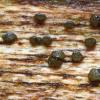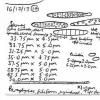
20-12-2025 23:08
Patrice TANCHAUDBonsoir, récolte sur sol sablonneux dans l'arri�

20-12-2025 15:47
Mirek GrycHi.These grew on pine wood that was heavily covere

18-12-2025 21:17
Pol DebaenstThe identification took me to Byssonectria deformi

15-12-2025 07:09
 Danny Newman
Danny Newman
indet. Rutstroemiaceae sp. on unk. fallen leavesMc

19-12-2025 10:10
Patrice TANCHAUDBonjour, récolte réalisée en milieu dunaire, a

18-12-2025 17:23
 Bruno Coué
Bruno Coué
Bonjour,je serais heureux d'avoir votre avis sur c

18-12-2025 18:07
Margot en Geert VullingsThese plumes were found on rotten wood.They strong

17-12-2025 18:35
 Michel Hairaud
Michel Hairaud
Bonjour à tous/Hi to everyone I am passing along
Patellaria or Lecanidion
Peter Thompson,
19-12-2013 15:26
I have been considering an ascomycete which seems to be growing in association with a lichen or alga. There is a slimy, green film on the wood, which is decorticated Betula pendula.
In many ways, it seems to fit best with the genus Patellaria (long, multiply septate spores, asci which rupture at the tip, no reaction to lugol and parallel, regularly septate hyphae in the excipulum).
There seem to be inconsistencies as well (olive green hymenium and paraphyses neither branched nor swollen at the tips).
I have attached a photograph of the fruit bodies and a sketch of the microscopy and wonder if anyone has an idea as to what it is.
Thank you,
Peter.
Gernot Friebes,
19-12-2013 15:33
Re : Patellaria or Lecanidion
Hi Peter,
how about Durella connivens?
Best wishes,
Gernot
how about Durella connivens?
Best wishes,
Gernot
Peter Thompson,
19-12-2013 18:06
Re : Patellaria or Lecanidion
Hello Gernot,
Thank you for your reply.
I overlooked Durella. It seems that D. connivens can have olive green hymenium as well as grey hymenium.
The green algal sliminess on the host and the 7-septate spores also fit. I was surprised to see that all of the spores with septa had exactly seven.
I think that you are right.
With Best Wishes,
Peter.
Thank you for your reply.
I overlooked Durella. It seems that D. connivens can have olive green hymenium as well as grey hymenium.
The green algal sliminess on the host and the 7-septate spores also fit. I was surprised to see that all of the spores with septa had exactly seven.
I think that you are right.
With Best Wishes,
Peter.


